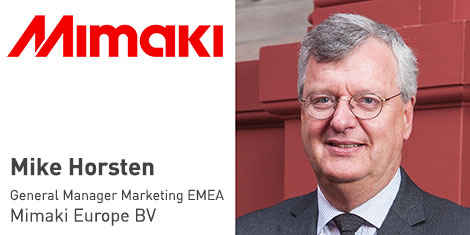
Mike Horsten is the General Manager Marketing EMEA for Mimaki Europe BV, the subsidiary of Mimaki Engineering Japan, and we are delighted to welcome him as a Guest Blogger on LFR. Here we bring you his second blog in which he discusses the technological progress made in the next ‘Holy Grail’ of digital printing: glass.
Some time ago, when I was looking at the possibilities for glass printing, it seemed that digital technology was going to leave this type of process alone. Glass was difficult to print on and the adhesion was problematic. The solution? Stick to traditional methods.
That was until the development of ceramic glass inks and other technologies started to appear in the market. However, these still required the glass to be baked after printing. This meant bigger markets were unable to start using this technology because of the non-existence of suitable finishing equipment in the digital world. Traditional glass manufacturing companies had these technologies in house so they could immediately start using the ceramic inks.
These challenges prompted us to embrace the glass industry with newer digital printed UV-Curable inks.
So ink technologies begun to change and some applications are now available following developmental help. So much of the help came from silkscreen technologies that have been available for a long time. This includes the introduction of primers to enhance adhesion, flaming, corona treatments, even plasma treatments. Tried and tested in the traditional world they helped the digital environment to understand that this was needed also for printing with UV inks.
The results varied and the quality of the adhesion was quite different to the old ways. The biggest difference was, how things were printed on the glass. For example, digital printing requires less ink so the ink combinations with the different glass types complicated the process while considered testing was and is needed to get good results. Unfortunately there is no correct way to print on glass.
That is why we are constantly reviewing what we are doing. The newest method we have been playing with is spraying a silica layer. It creates an adhesive bond layer that UV-Curable ink loves. So at last we have discovered a good match between pretreatment and the UV curable inks that we have been using in the digital world.
Now with the same printers that we have been using for POS signage, short run packaging and even promotional items we can now print on glass. The exciting thing about the glass printing world is that it offers an extensive array of production options from printing on kitchen cabinets, glass meeting room doors, glass table-tops to bottles and cosmetic flasks.
And the results are stunning. The quality of the prints are better than any achieved by traditional processes and the amount of different colours available is very impressive. So much so nobody could have believed this a few years ago.
The glass industry has a new friend - digital print. Short run production, special objects or even art can now be printed on glass and finished with a UV coating for protection.
The way to add value and create much needed margins with high quality glass printing has now become completely transparent. What's stopping us?
Let's create... together.
About Mike Horsten: Since joining Mimaki Europe more than three years ago, Mike Horsten has been responsible for promoting the Mimaki brand and marketing its digital printing technologies and cutting solutions. He is charged with making the Mimaki brand the de facto digital print leader within the sign and graphics, industrial printing and textile and apparel markets.
Mike has more than 30 years of production and international marketing experience, providing a wealth of inspirational ideas on how vendors and suppliers can work together to achieve a better digital printing world.
He encourages businesses to develop in a more sustainable and green way, without losing sight of company profitability and margin goals.




